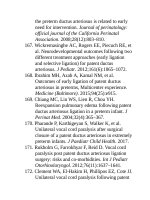Andersons pediatric cardiology 1858
Bạn đang xem bản rút gọn của tài liệu. Xem và tải ngay bản đầy đủ của tài liệu tại đây (166.99 KB, 3 trang )
catheterizationwithangiographyfoundnodetectabledifferencesinimmediate
andshort-termpostoperativeoutcomes,albeitinselectedpatients.211
Table71.8
ImportantElementsofthePre-SuperiorCavopulmonaryConnection
Evaluation
Hemodynamics
Systemicbloodflow
Pulmonarybloodflow
Pulmonaryarterypressure
Atrialpressure/end-diastolicpressure
Systemicandpulmonaryvascularresistance
Pressuregradients:atrialseptum,pulmonaryarteries,pulmonaryveins,atrioventricularvalve,
ventricularoutflowtract,aorticarch
Valvarregurgitantfraction
Anatomy
Superiorvenacava
Pulmonaryarteries
Ventricularoutflowtract
Aorticarch
Other
Ventricularfunction
Atrioventricularvalveregurgitation
Venovenouscollaterals(potential)
Aortopulmonarycollaterals
Modality
Cath,CMR
Cath,CMR
Cath
Cath
Cath
Cath,CMR,
echo
CMR
Cath,CMR,
CT,echo
Cath,CMR,
CT,echo
Cath,CMR,
CT,echo
Cath,CMR,
CT,echo
Cath,echo,
CMR
Cath,echo,
CMR
Cath,CMR,
CT
Cath,CMR,
CT
Cath,Cardiaccatheterization;CMR,cardiacmagneticresonance;CT,computedtomography;
echo,echocardiography
SurgicalStrategies
Themostcommonanatomyencounteredisapatientwithlevocardiaandasingle
rightsuperiorvenacava.Inthissettingtwostrategiesarecommonlyemployed
toachieveaconnectionbetweenthesuperiorvenacavaandtheconfluent
pulmonaryarteries.ThesimplestisthebidirectionalGlennshunt(Fig.71.9)
(Video71.2).212Thesuperiorvenacavaistransectedatitsinsertionintothe
rightatriumandananastomosisisconstructedbetweenthesuperiorvenacava
andtheproximalrightpulmonaryartery.Thisisgenerallydoneon
cardiopulmonarybypassandincludescannulationofthesuperiorvenacavaand
rightatrium;butifadequatepulmonarybloodflowcanbemaintainedduringthe
procedureandthebranchpulmonaryarteriesdonotrequirepatchaugmentation,
theprocedurecanbedoneoffbypass.Anotheroptionisthehemi-Fontan(Fig.
71.10).Thisisamoreextensiveprocedureandrequirescardiopulmonarybypass
andaorticcross-clampingwithcardioplegia.Thepulmonaryarteriesare
connectedwidelytothesuperiorvenacavaandthecephaladportionoftheright
atrium.Apatchseparatingthesuperiorcavopulmonaryanastomosisfrom
inferiorportionoftherightatriumcompletestheprocedure.Thedecision
betweenabidirectionalGlennshuntandahemi-Fontanisprimarilybasedon
institutionalexperienceandthepreferenceforthethird-stageprocedure.The
hemi-FontanallowsforstraightforwardconstructionofalateraltunnelFontan,
whereasthebidirectionalGlennshuntisbettersuitedforanextracardiacFontan.
DatafromTheSingleVentricleReconstructionTrialshowthatthebidirectional
Glennwasperformedmuchmoreoftenthanthehemi-Fontan(73%vs.27%).
Althoughmortalityandhospitallengthofstayweresimilarforbothprocedures,
thehemi-Fontanhadalowercomplicationandreinterventionrateat1year.13,213
Transientsinusnodedysfunctionismorecommonafterthehemi-Fontan
operation,andthelonger-termprevalenceofsinusnodedysfunctionissimilar
witheithertypeofSCPC.214–216
FIG.71.9 ThebidirectionalGlennshuntisaformofsuperior
cavopulmonaryanastomosisinwhichthesuperiorvenacavaisdividedat
theinsertionintotherightatriumandananastomosisisconstructedwitha
proximalbranchpulmonaryartery.Ingeneraladditionalarterialsourcesof
pulmonarybloodflowsuchasasystemic-to-pulmonaryarteryshuntare
divided.(FromJonasRA.Theintra/extracardiacconduit.SeminThorac
CardiovascSurgPediatrCardSurgAnnu.2011;14:11–18.)
FIG.71.10 Thehemi-Fontanprocedureisanotherformofsuperior
cavopulmonaryanastomosis.Thesuperiorcavalveinisnotdivided;
instead,ananastomosisisconstructedbetweenthesuperiorcavalvein









